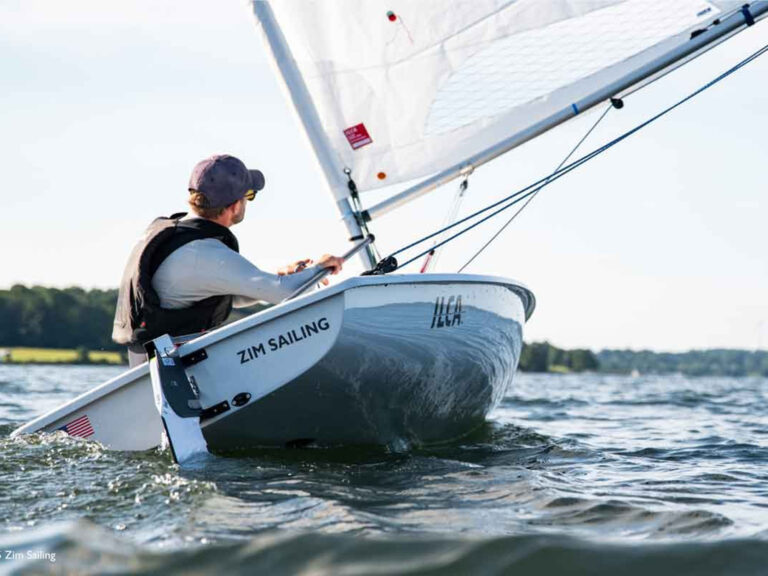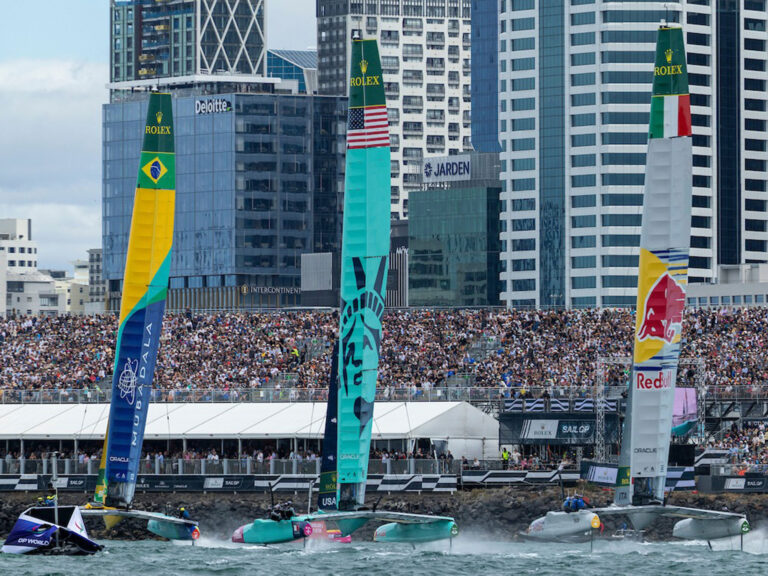
BOTY-A2
High winds and big waves presented a significant challenge to the BOTY judges to test sail the lightweight single-handed A2 catamaran. Chuck Allen, the youngest and most agile of our panel, volunteered for this hazardous duty, which occured at the very upper wind range allowed for racing by the class. Chuck, who had never been on an A Cat, learned fast as he immediately flipped while adjusting the boards, but was able to quickly right the boat and regain control. He then proceeded to put the A2 through her paces for the next 45 minutes, building confidence as he sorted out what one has to do the stay upright on a 165-pound beach cat with a 30-foot tall rig, which one competitor has described as “like trying to sail a potato chip in heavy air.” Chuck reached his stride when the chase boat could no longer keep up with his blinding speed, and at the end of his introduction to the high-tech world of single-handed cat sailing he had just one comment: “I want one.” Fortunately, as a contestant at the recent A Class North Americans, I was able to earlier evaluate the A2 and her performance in more detail in lighter winds. There, this new craft was not hard to pick out of the many boats on the beach, with her radically reversed bows that obviously pushed to a new level a trend that began several years ago with the German/Australian-inspired “flyer” design. The bows for this concept are typically reversed and overly full down low, quickly tapering upward to a rounded deck profile that continues well aft to the front beam. The “flyer” design, which has dominated class competition in recent years, proved that this strange bow adaptation helped a boat to keep a bow down attitude when driving to weather; with the bows piercing through waves rather than reacting to them with energy-absorbing pitching. The other advantage is windage reduction, which is no small thing in this highly competitive class. But staying on your feet downwind in heavy air has always been the problem with the A Cat, where the tall, high-aspect rigs can quickly overpower the bows on the slender 18-foot hulls. The reversed bows on the standard flyer proved to be no more hazardous in this regard than the standard bows of the past and the question was, just how far can this concept be taken without seriously increasing the capsize danger. This question was certainly on a lot of minds as everyone gave a pre-regatta check to Pete Melvin’s new A2 as he assembled the boat from boxes recently shipped from their California factory, just a day before racing was to begin in Traverse City, Mich. After the first three days of all heavy-air races, where gusts into the high 20s were commonplace, the results were in. The A2 with Pete Melvin at the helm was in first place with only one capsize. Most other experienced competitors, in a wide range of other designs, also had their share of capsizes. Thus, the radical-bowed A2 seemed to stay on its feet at least as well as other boats in the fleet and also get to the finish line first. A further Melvin/Morrelli design change from the norm is a more rounded hull treatment that extends from the bows flowing through to an oval shaped transom what appears to be a further attempt to reduce windage. The girth of the hull between the beams is noticeably wider, with no distinct chine at this normal trampoline intersection. The trampoline is not lashed to the hull, but is mainly supported by a cable lashed in a slight arc between the beams, with several additional lashings added between the cable and hull. The gap between the hull and trampoline is left open (as well as on some other boats in the class) providing an easy foothold to more quickly launch out on the trapeze. Building these boats down to minimum weight (all-up and ready to sail at 165 pounds) but still strong enough to take a beating, is no small task. Trying to do this on a production basis at an affordable price point is really difficult. All-carbon construction has become standard practice in the class where hulls must weigh in at 40 pounds or less. The A2 hulls are unique in that they are built using a new resin infusion process that is able to consistently produce a lightweight, void-free carbon laminate. While various infusion processes have been used for some time, it has been mostly in larger craft with much thicker laminates. The A2 hulls are one of the first lightweight cored laminates to successfully utilize this process. Geno Morrelli and his crew have spent a good deal of time to develop and fine tune the techniques necessary to make infusion work at this extreme high-tech level, which should pay off with tough, void-free hulls that hold up well for many years of hard sailing at a price that class participants can afford. Both the beams and mast are of autoclave-cured, carbon-prepreg construction, with the beautifully built and rigged 30-foot Hall Spar coming in at a mere 25 pounds. The high-aspect rudders and boards are, of course, all carbon, but feature a unique foil shape, especially on the boards, with a significant “reverse hollow” from max quarter chord to the trailing edge. The substantial front beam is an oval “D” section that provides adequate strength and stiffness to eliminated the need for a dolphin striker support below. The A2 as sailed by Pete Melvin also stood in contrast to much of the competition in its utter simplicity, with a basic layout, featuring a minimum of go-fast gadgets and lines to tend. The A Class Cat is difficult boat to sail to full potential, and it could be that many gadgets-obsessed competitors have spent way too much time tinkering with control schemes and not enough time out on the water. Certainly Pete Melvin’s solid win in a 12 race series at this year North Americans with a quickly assembled, untuned and simply rigged new A2 design, has given many in the class much to think about. The really good news is that for the first time in many years, an easy-to-sail, well-built and competitive A Class Cat will be available in this country to anyone who wants to join in the fun. This new potential will only add to a strong and growing class of purist sailors who want to sail the fastest thing available that one person can control and carry up on a beach. This convert can say without hesitation, that after over 40 years of sailing every kind of multihull, the modern A Class Cat is my favorite, if not just for the pure joy of sailing.





